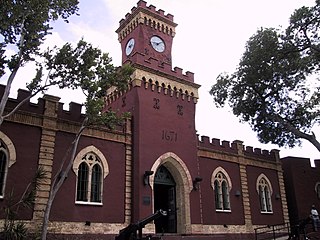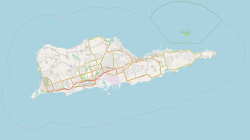
Christiansted National Historic Site commemorates urban colonial development of the Virgin Islands. It features 18th and 19th century structures in the heart of Christiansted, the capital of the former Danish West Indies on St. Croix Island.

The Boca Chita Key Historic District is a U.S. historic district within the Biscayne National Park in Miami-Dade County, Homestead, Florida. Located on the northwest section of Boca Chita Key, delimited by Biscayne Bay in the north and west and a half ruined stone wall on its southern side, it contains three historic buildings and the Boca Chita Lighthouse. On 1 August 1997, it was listed in the National Register of Historic Places for its architectural, historical and recreational values.

St. Peter's Evangelical Lutheran Church, or Iglesia Luterana San Pedro, is a historic church complex located in the Walker's Point neighborhood of Milwaukee, Wisconsin. Its buildings are listed on the National Register of Historic Places.

Mother of God Parish is a parish church of the Roman Catholic Diocese of Covington, Kentucky, United States, located at 119 West 6th Street in Covington. The official title of the parish is The Assumption of Mary, Mother of God, Parish. The church was listed on the National Register of Historic Places in 1973. It was also included in the Mutter Gottes Historic District which was listed on the National Register in 1980.

Fort Christian is a Dano-Norwegian-built fort in Charlotte Amalie, Saint Thomas, U.S. Virgin Islands. Built 1672-1680, early in the first successful colonial establishment on the island, the fort served as a critical point of defense and government during the entire period of Dano-Norwegian, and later Danish, administration, which ended in 1917 with the sale of the islands to the United States. It currently holds the St. Thomas Museum, which holds artifacts and art of the Dano-Norwegian period. It was designated a U.S. National Historic Landmark in 1977.

The former First Baptist Church is a historic Baptist church building located at 8601 Woodward Avenue in Detroit, Michigan. Built in 1909, it was designed by architect Guy J. Vinton in the Late Gothic Revival style. It is now the Peoples Community Church. The building was added to the National Register of Historic Places on August 3, 1982.

The Empire Building is an office skyscraper at 71 Broadway, on the corner of Rector Street, in the Financial District of Manhattan in New York City. It was designed by Kimball & Thompson in the Classical Revival style and built by Marc Eidlitz & Son from 1897 to 1898. The building consists of 21 stories above a full basement story facing Trinity Place at the back of the building and is 293 feet (89 m) tall.

North Manitou Island Lifesaving Station, also known as North Manitou Coast Guard Station, is a complex of buildings located on North Manitou Island, which is part of Sleeping Bear Dunes National Lakeshore in Michigan, in the U.S. The complex was constructed as a life-saving station. It is the only remaining station which was in use during all three periods of lifesaving service history, from the early volunteer period through operation by the United States Life-Saving Service and the United States Coast Guard. It was declared a National Historic Landmark in 1998.

The Society of the Congregational Church of Great Barrington is an historic church building and parish house located at 241 and 251 Main Street in Great Barrington, Massachusetts. It is the fourth church of a congregation whose first meetings were held in 1743.

The Old Faithful Historic District in Yellowstone National Park comprises the built-up portion of the Upper Geyser Basin surrounding the Old Faithful Inn and Old Faithful Geyser. It includes the Old Faithful Inn, designed by Robert Reamer and is itself a National Historic Landmark, the upper and lower Hamilton's Stores, the Old Faithful Lodge, designed by Gilbert Stanley Underwood, the Old Faithful Snow Lodge, and a variety of supporting buildings. The Old Faithful Historic District itself lies on the 140-mile Grand Loop Road Historic District.

The Lake Fish Hatchery Historic District comprises nine buildings built between 1930 and 1932 by the U.S. Fish and Wildlife Service in the National Park Service Rustic style. The buildings exhibit a consistency of style and construction, with exposed gable trusses and oversized paired logs at the corners, all with brown paint. The district is located on the shore of Yellowstone lake near the Lake Hotel The hatchery was established to provide Yellowstone cutthroat trout eggs for state and federal hatcheries outside Yellowstone.

First Presbyterian Church and Manse is a historic Presbyterian church located at West Madison Street and Park Avenue in the Mount Vernon-Belvedere neighborhood of Baltimore, Maryland, United States. The church is a rectangular brick building with a central tower flanked by protruding octagonal turrets at each corner. At the north end of the church is a two-story building appearing to be a transept and sharing a common roof with the church, but is separated from the auditorium by a bearing wall. The manse is a three-story stone-faced building. The church was begun about 1854 by Nathan G. Starkweather and finished by his assistant Edmund G. Lind around 1873. It is a notable example of Gothic Revival architecture and a landmark in the City of Baltimore.

St. Henry's Catholic Church is a historic Roman Catholic church in St. Henry, Ohio, United States. Built in the late nineteenth century, it remains the home of a functioning congregation, and it has been recognized as a historically significant building because of its architecture.

St. Aloysius Catholic Church is a historic Roman Catholic church in Carthagena, an unincorporated community in Marion Township, Mercer County, Ohio, United States. Built in the late nineteenth century, it remains the home of an active parish, and it has been designated a historic site because of its well-preserved architecture.

New Herrnhut Moravian Church is a historic Moravian church in Saint Thomas, U.S. Virgin Islands. The Moravians, a Protestant religious group based in the town of Herrnhut in Saxony, began missionary work in 1732 in St. Thomas and were the first Protestants to begin missionary work among slaves and free Blacks in the Danish West Indies. Missionary work on St. Thomas was initially opposed by planters who didn't want slaves to receive education or religious instruction.

The First Presbyterian Church of Newtown is a historic Presbyterian church in the Elmhurst neighborhood of Queens in New York City. The church complex is composed of the main church, a parish hall, and a manse. The current complex at 54th Avenue, between Seabury Street and Queens Boulevard, is the fifth church complex built for the congregation.

Roberts Park Methodist Episcopal Church, whose present-day name is Roberts Park United Methodist Church, was dedicated on August 27, 1876, making it the oldest church remaining in downtown Indianapolis. Diedrich A. Bohlen, a German-born architect who immigrated to Indianapolis in the 1850s, designed this early example of Romanesque Revival architecture. The church is considered one of Bohlen's major works. Constructed of Indiana limestone at Delaware and Vermont Streets, it has a rectangular plan and includes a bell tower on the southwest corner. The church is known for its interior woodwork, especially a pair of black-walnut staircases leading to galleries (balconies) surrounding the interior of three sides of its large sanctuary. The church was added to the National Register of Historic Places on August 19, 1982. It is home to one of several Homeless Jesus statues around the world, this one located behind the church on Alabama Street.

Bordeaux, also known as Estate Bordeaux, is a historic former sugar plantation located on the West End of Saint Thomas, U.S. Virgin Islands. It was listed on the U.S. National Register of Historic Places in 1978. The listing included three contributing buildings and a contributing structure.

The Hamburg-America Shipping Line Administrative Offices, also known as United States District Courts Building, in Charlotte Amalie in Saint Thomas, U.S. Virgin Islands, was built in 1914. It was listed on the National Register of Historic Places in 1978.

The Friedensthal Mission, southwest of Christiansted in Saint Croix, U.S. Virgin Islands, was partly built by 1830. Also known as Friedensthal Moravian Church, it was listed on the National Register of Historic Places in 1978. In German, Fridensthal means "valley of peace".



























